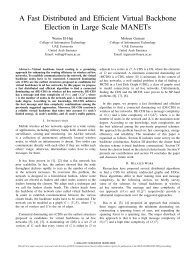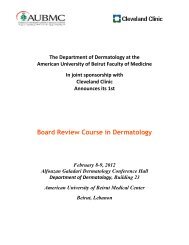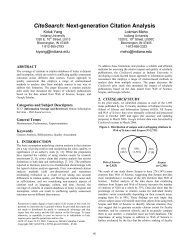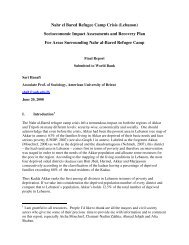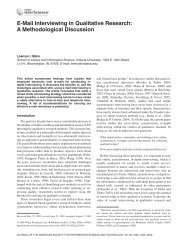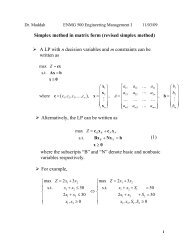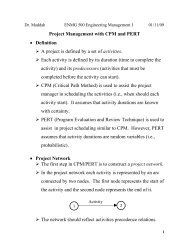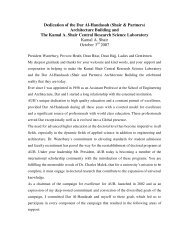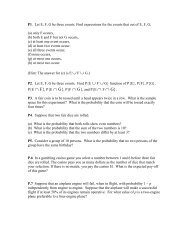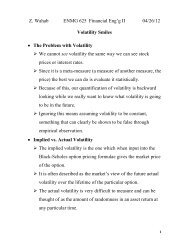Considerations for Litopenaeus vannamei Reared in Inland Low ...
Considerations for Litopenaeus vannamei Reared in Inland Low ...
Considerations for Litopenaeus vannamei Reared in Inland Low ...
You also want an ePaper? Increase the reach of your titles
YUMPU automatically turns print PDFs into web optimized ePapers that Google loves.
D. Allen Davis, Imad. P. Saoud, William J. McGraw, and David. B. Rouse 76Table 1. Ionic profile of various <strong>in</strong>land well waters from the southern USA. Numbers are concentration <strong>in</strong> mg.L -1 . Sources are from West Alabama (A) ,Australia (AU) , south Florida (F) , East Mississippi (M) and West Texas (T) .IonsInstantOcean C A HC A JS A L A LC A KM A NH A O A R A TC A W ASal<strong>in</strong>ity 4.0 6.1 0.7 16.3 7.3 3.8 3.7 0.9 6.0 4.5 3.4 3.4Na 1316.3 2483.1 219.1 5732.6 2504 1480.9 1316.2 364.1 2394.7 1957 1395.1 1122.5Ca 42.4 174.29 3.02 104.7 540 29.8 330.5 5.24 109.06 156.87 55 281.6Mg 132.26 30.29 0.35 76.7 63.6 6.7 14.5 0.96 28.63 28.24 12.4 53.9K 47.32 16.45 2.2 34.4 15.4 8.5 10.1 3.48 15.4 12.21 9.5 7.9P 0.33 0 0 0.4 0.6 0 0 0 0.15 0 0 0Fe 0 0 0 80 1.2 0 0.2 0 0 0 0 0Mn 0 0.1 0 0.1 0.1 0 3.3 0 0 0.03 0 0.2Zn 0 0.01 0 0 0.1 0 0.1 0 0 0 0 0.4B 0.73 1.1 0.29 7.3 0.4 1.5 0.1 0.41 1.28 1.38 1.1 1Mo 0 0 0 0 0 0 0.5 0 0 0.03 0.4 0Al 0 0 0 0.1 0.9 0 0.4 0 0 0 0 0Ba 0.02 0.76 0.01 2.3 1.4 0.2 0.4 0.02 0.7 1.39 0.3 7Cr 0 0 0 0 0.1 0 0 0 0 0 0 0Cl 1922.1 3589 332.9* 9807 5873 2129 2489 553.8* 3859 3192.5* 1949 2514--SO 4(0) <strong>in</strong>dicates below detectable limits.(.) is <strong>for</strong> values that have not been estimated.(*) is <strong>for</strong> values that have been calculated mathematically.262.3 0 . 0 12.1 0 0 . 6.05 . 0 0
<strong>Considerations</strong> <strong>for</strong> <strong>Litopenaeus</strong> <strong>vannamei</strong> reared <strong>in</strong> <strong>in</strong>land low sal<strong>in</strong>ity waters 77Table 1. Cont<strong>in</strong>ued.IonsInstantOcean P M FL F WT T LA T FO A RT A WC A HBOI F B AUSal<strong>in</strong>ity 4.0 0.79 2.2 8.9 3.5 5.1 2.9 23.5 1.0 19.6Na 1316.3 299.8 987.2 2799.8 1015.5 1990.3 1164.6 9021.1 290 5140Ca 42.4 3.8 51.5 697.8 147.1 124.3 44.5 250.8 54 772Mg 132.26 0.7 60.6 455.3 100 28.6 10.4 126.5 53 948K 47.32 3.2 35.3 63.9 17.8 12 8.7 38.2 15 30P 0.33 0.1 0 4.1 1.1 0 0 0.9 0 10.9Fe 0 0 0.3 7.3 1.2 3.3 0 5.4 0 0.5Mn 0 0 0 0 0.1 0.2 0 0.3 0 0Zn 0 0 0 0.1 0 0.1 0.1 0.1 0 0B 0.73 0.4 0.9 1.6 4.3 0.9 0.9 12.6 0.25 0.26Mo 0 0 1.2 0.2 0 0.4 0.7 0.5 0 0Al 0 0 0 1.5 0.3 0 0 0 0 0Ba 0.02 0 0 0 0.1 0.7 0.3 5.8 0.023 0Co 0 0 0 0 0 1.8 0 2.2 0 0Cl 1922.1 450 1070 2769 1230 3200.6* 1689 14007.3* 450 12380--SO 4(0) <strong>in</strong>dicates below detectable limits.(.) is <strong>for</strong> values that have not been estimated.(*) is <strong>for</strong> values that have been calculated mathematically.262.3 0 806 3617 1127 . 0 . 140 265
<strong>Considerations</strong> <strong>for</strong> <strong>Litopenaeus</strong> <strong>vannamei</strong> reared <strong>in</strong> <strong>in</strong>land low sal<strong>in</strong>ity waters 79Table 3. Mean survival (%) of 10-, 15- and 20-day old postlarval <strong>Litopenaeus</strong> <strong>vannamei</strong>, 24 and 48 hoursafter reach<strong>in</strong>g the target sal<strong>in</strong>ity endpo<strong>in</strong>t (Trial 2). Values with<strong>in</strong> a column hav<strong>in</strong>g a * are significantlydifferent from the control (12 ppt), us<strong>in</strong>g Dunnett’s t-test (P < 0.05).10-d 15-d 20-dSal<strong>in</strong>ity 24 h 48 h 24 h 48 h 24 h 48 h0 50* 0* 0* 0* 0* 0*1 57* 35* 100 88 97 822 70* 45* 100 95 100 904 100 100 100 93 100 1008 100 92 100 90 100 9312 100 100 100 95 98 95PSE a 6.9 7.0 - 4.7 1.5 4.3a Pooled Standard ErrorAssum<strong>in</strong>g that mar<strong>in</strong>e water is optimal <strong>for</strong> shrimp culture, results of the present workclearly <strong>in</strong>dicate an effect of age on sal<strong>in</strong>ity tolerance and <strong>in</strong>dicates that L. <strong>vannamei</strong>younger than PL 15 should not be acclimated to sal<strong>in</strong>ities lower than 4 ppt. However, PL 15and older can be acclimated down to 1 ppt. S<strong>in</strong>ce the acclimation of the shrimp was doneunder similar rates of acclimation one could conclude that the acclimation procedure wastoo fast. Consequently, a second experiment was designed to evaluate the effects of rate ofsal<strong>in</strong>ity reduction. The data from this experiment is presented <strong>in</strong> Table 4. Results <strong>in</strong>dicatethat sal<strong>in</strong>ity end po<strong>in</strong>t and acclimation rate had no effect on survival of PL 15 and PL 20 .Significant differences between treatments were found as early as 24 hours afteracclimation with PL 10 . However, acclimation rate did not significantly <strong>in</strong>fluence survivalwhereas sal<strong>in</strong>ity end po<strong>in</strong>t did. Survival of PL 10 acclimated to 4 ppt was significantlyhigher than that of PL 10 acclimated to 1 ppt, irrespective of the rate of acclimation.
D. Allen Davis, Imad. P. Saoud, William J. McGraw, and David. B. Rouse 80Table 4. Mean survival (%) of 10-, 15- and 20-day old post larval <strong>Litopenaeus</strong> <strong>vannamei</strong>, 24 and 48 hoursafter reach<strong>in</strong>g the two target sal<strong>in</strong>ity endpo<strong>in</strong>ts us<strong>in</strong>g three rates of acclimation. Difference <strong>in</strong> percent survivaldue to the ma<strong>in</strong> effects and their <strong>in</strong>teractions are <strong>in</strong>dicated at the bottom of the table (nsd = no significantdifference).10-d 15-d 20-dSal<strong>in</strong>ity Rate 24h 48h 24h 48h 24h 48h1 High 40 23 100 88 98 87Medium 57 42 100 92 100 83<strong>Low</strong> 65 43 100 92 100 884 High 97 77 100 93 100 93Medium 98 77 100 98 100 88<strong>Low</strong> 98 83 100 88 100 92P value Sal<strong>in</strong>ity 0.0001 0.0001 nsd nsd nsd nsdRate 0.2080 0.2481 nsd nsd nsd nsdInteraction 0.3795 0.4392 nsd nsd nsd nsdBased on the above mentioned results it would appear that age has a more pronouncedimpact on the shrimps’ ability to acclimate to low sal<strong>in</strong>ity. Although the data suggests thata sal<strong>in</strong>ity reduction of 46% per hour is feasible, it should be noted that the present work wasconducted <strong>in</strong> controlled laboratory sett<strong>in</strong>gs and low stock<strong>in</strong>g densities of shrimp. Theauthors suggest an acclimation rate of 4 ppt hr -1 down to a sal<strong>in</strong>ity of 4 ppt and a reductionrate of 1 ppt hr -1 thereafter as a more conservative approach to sal<strong>in</strong>ity acclimation. Thisconservative acclimation rate was used <strong>in</strong> subsequent experiments to test the various lowsal<strong>in</strong>ity well water sources.Data from a series of biological assays with various well water sources are presented <strong>in</strong>Table 5 and the ionic composition of the various waters are presented <strong>in</strong> Table 1. Fortyeighthour survival of L. <strong>vannamei</strong> postlarvae <strong>in</strong> <strong>in</strong>land sal<strong>in</strong>e well water varied with PL ageand water source. Survival <strong>in</strong> eight of the 15 waters tested was different from the control atPL 10 while survival <strong>in</strong> only seven and five waters were different from the controls at PL 15and PL 20 , respectively. Some waters were not suitable <strong>for</strong> shrimp acclimation at all PL
<strong>Considerations</strong> <strong>for</strong> <strong>Litopenaeus</strong> <strong>vannamei</strong> reared <strong>in</strong> <strong>in</strong>land low sal<strong>in</strong>ity waters 81stages tested.Table 5. Mean survival (%) of <strong>Litopenaeus</strong> <strong>vannamei</strong> <strong>in</strong> various <strong>in</strong>land sal<strong>in</strong>e well waters compared tosurvival <strong>in</strong> an artificial seawater control, 48 hours after <strong>in</strong>itiat<strong>in</strong>g acclimation.Experiment 1.PL 10 PL 15 PL 20Average Wt. (mg) 3.85 8.42 .75L (7.3 ppt) 48.3* 51.7* 90.0C (5.6 ppt) 83.3 70.0 90.0R (4.5 ppt) 75.0 75.0 91.7Control (4ppt) 80.0 85.0 93.3Experiment 2.Average Wt. (mg) 4.77 5.34 25.01LC (3.8 ppt) 63.3 55.0* 73.3JS (16.3 ppt) 0.0* 0.0* 0.0*Control (4ppt) 73.3 a 97.8 85.0Experiment 3.Average Wt. (mg) 1.03 6.89 11.82P (0.7 ppt) 6.7* 45.0* 36.7*TC (3.4 ppt) 0.0* 28.3* 28.3*FL (2.2 ppt) 95.0 98.3 98.3WT (8.9 ppt) 65.0* 91.7 100.0LA (3.5 ppt) 81.7 95.0 95.0KM (3.7 ppt) 0.0* 41.7* 50.0*Control 4ppt 93.3 100.0 100.0Experiment 4.Average Wt. (mg) 2.98 8.77 19.48O (6.0 ppt) 83 98 88NH (0.9 ppt) 43* 87 55*HC (0.7 ppt) 25* 65* N/AControl (4ppt) 83 88 92Experiment 5.Average Wt. (mg) 2.15 7.17 14.54W (4.3) 90 98.3 96.7Control (4ppt) 92.5 98.3 95.0“ a ” = significantly different from other controls at PL10.* Indicates that the value is different from the control.
D. Allen Davis, Imad. P. Saoud, William J. McGraw, and David. B. Rouse 82The two lowest sal<strong>in</strong>ities were those of HC and P, both be<strong>in</strong>g less than 1 ppt. Survival <strong>in</strong>these two waters was significantly lower than <strong>in</strong> the controls. The highest sal<strong>in</strong>ity was thatof JS at 16.3 ppt, yet total mortality resulted when L. <strong>vannamei</strong> PLs were ma<strong>in</strong>ta<strong>in</strong>ed <strong>in</strong> JSwater. No correlation was found between PL survival and <strong>in</strong>land well water sal<strong>in</strong>ity.Excellent survival was observed <strong>in</strong> the FL water at 2.2 ppt while low survival was observed<strong>in</strong> the TC and KM waters at 3.4 ppt and 3.7 ppt, respectively.To evaluate the <strong>in</strong>fluence of ionic composition of the waters on PL survival, correlationanalyses were conducted us<strong>in</strong>g the collected data. Post-larval survival was correlated topotassium (K + ) concentration at all PL ages tested (Tables 6 and 7). Weaker correlationswere also found between PL survival and magnesium (Mg 2+ ), manganese (Mn 2+ ) andsulfate (SO 4 2- ).
<strong>Considerations</strong> <strong>for</strong> <strong>Litopenaeus</strong> <strong>vannamei</strong> reared <strong>in</strong> <strong>in</strong>land low sal<strong>in</strong>ity waters 83Table 6. Regression models describ<strong>in</strong>g the stepwise selection of ions possibly responsible <strong>for</strong> <strong>Litopenaeus</strong><strong>vannamei</strong> PL survival at various ages.PL 10VariableParameter Standard Error Type II SumF Prob>FEstimateof SquaresIntercept -0.7244 0.6456 4.4893 1.26 0.2663Mg -0.4302 0.0444 334.6681 93.85 0.0001K 1.3813 0.1311 395.9223 111.03 0.0001P -2.7568 1.8309 8.0845 2.27 0.1374Fe 6.7255 1.5637 65.9666 18.50 0.0001Mo -21.8925 2.0247 416.9027 116.92 0.0001Ba 5.8310 0.7086 241.4294 67.71 0.0001SO4 0.0206 0.0015 631.8574 177.20 0.0001PL 15VariableParameterEstimateStandard ErrorType II Sumof SquaresFProb>FIntercept 11.6377 0.7497 1598.9288 240.95 0.0001K 0.0927 0.0176 184.1333 27.75 0.0001Mn -1.0847 0.4220 43.8432 6.61 0.0125Cl -0.0011 0.0003 77.3536 11.66 0.0011PL 20VariableParameterEstimateStandard Error Type II Sum of Squares F Prob>FIntercept 5.1099 0.7601 252.5802 45.19 0.0001K 0.1699 0.0190 449.1629 80.36 0.0001B 1.5203 0.3185 127.3314 22.78 0.0001Al -2.3100 0.7764 49.4836 8.85 0.0041Ba 3.4319 0.6964 135.7456 24.29 0.0001ΣPLVariableParameterEstimateStandard Error Type II Sum of Squares F Prob>FIntercept 5.9754 0.5248 968.4080 129.66 0.0001Mg -0.2847 0.0299 679.1963 90.93 0.0001K 0.8452 0.0754 937.3465 125.50 0.0001B -1.5345 0.3824 120.2627 16.10 0.0001Mo -17.7638 1.8929 657.7885 88.07 0.0001Al 2.9663 1.3110 38.2353 5.12 0.0247Ba 4.5949 0.6140 418.3574 56.01 0.0001SO4 0.0232 0.0024 711.4510 95.25 0.0001
D. Allen Davis, Imad. P. Saoud, William J. McGraw, and David. B. Rouse 84Table 7. Pearson’s correlation coefficient between <strong>Litopenaeus</strong> <strong>vannamei</strong> PL survival and various ions <strong>in</strong> the waters tested.PL 10 PL 15 PL 20 All agesPearson’s P > ⏐R⏐ Pearson’s P > ⏐R⏐ Pearson’s P > ⏐R⏐ Pearson’s P > ⏐R⏐Na 0.332 0.004 -0.211 0.075 0.344 0.004 0.174 0.011Ca -0.043 0.717 -0.216 0.069 0.112 0.362 -0.039 0.572Mg 0.328 0.005 0.344 0.003 0.465
<strong>Considerations</strong> <strong>for</strong> <strong>Litopenaeus</strong> <strong>vannamei</strong> reared <strong>in</strong> <strong>in</strong>land low sal<strong>in</strong>ity waters 85The present work confirms reports that L. <strong>vannamei</strong> can be acclimated to some <strong>in</strong>land, lowsal<strong>in</strong>ity well waters. The fact that survival was higher <strong>in</strong> some waters than <strong>in</strong> othersunderscores the need <strong>for</strong> water suitability evaluations. All sal<strong>in</strong>e well waters are not equal,even if they orig<strong>in</strong>ate from the same aquifer but at different locations. The C water and theTC water are from wells that are less than 3 km apart and drilled <strong>in</strong>to the same aquifer, yetthey have different sal<strong>in</strong>ities and ionic compositions. Furthermore, PL acclimated muchbetter to the C water than to the TC water and juveniles survived and grew better <strong>in</strong> the<strong>for</strong>mer than <strong>in</strong> the latter.Based on these results, the ionic composition of a sal<strong>in</strong>e water appears to be more importantthan sal<strong>in</strong>ity with regards to its effect on shrimp survival and growth. Cawthorne et al.(1983) demonstrated that s<strong>in</strong>gle salt solutions (NaCl) were not suitable <strong>for</strong> shrimp culture atany sal<strong>in</strong>ity, although <strong>in</strong> seawater, the ions most important <strong>in</strong> osmoregulation are chlorideand sodium (Castille & Lawrence, 1981; Ferraris et al., 1986; Parado-Estepa et al., 1987).Results of the present study as well as ongo<strong>in</strong>g research suggest that, <strong>in</strong> the presence ofadequate sal<strong>in</strong>ity, potassium was the ion most correlated with PL survival. Similar resultswere found by Adrian Coll<strong>in</strong>s (personal communication) work<strong>in</strong>g with shrimposmoregulation <strong>in</strong> Australia as well as Fielder et al. (2001) work<strong>in</strong>g with the snapperPagrus auratus. These results could be due to the fact that Cl - and Na + concentrations <strong>in</strong> allthe waters tested were at levels suitable <strong>for</strong> shrimp survival, but potassium was not.Prelim<strong>in</strong>ary studies <strong>in</strong>volv<strong>in</strong>g supplementation of K + ions to some of the waters that wereunsuitable <strong>for</strong> shrimp culture, presented favorable results. When shrimp were ma<strong>in</strong>ta<strong>in</strong>ed <strong>in</strong>waters <strong>in</strong> which K + was <strong>in</strong>creased to equal its concentration <strong>in</strong> 4 ppt seawater, PL survival<strong>in</strong>creased from < 50% to more than 85%. Other ions also found to be correlated withsurvival (Mg 2+ and SO 4 2- ) were reported as important <strong>in</strong> osmoregulation by Mantel andFarmer (1983).LONG-TERM SURVIVAL IN WELL WATERS.To evaluate the effects of selected water sources on the growth of shrimp, a 4 week growthtrial was <strong>in</strong>itiated under laboratory conditions. One week be<strong>for</strong>e the start of the growth trial,four recirculat<strong>in</strong>g systems consist<strong>in</strong>g of four 144-L (0.6 x 0.6 x 0.4 m) polyethylene tankseach, were filled with sal<strong>in</strong>e water. Three systems were filled with sal<strong>in</strong>e well water andone with reconstituted seawater at 4 ppt. Water from each system flowed through acommon dra<strong>in</strong> <strong>in</strong>to a sump tank where it was circulated through a trickl<strong>in</strong>g biological filterand returned to the tanks. Temperature was ma<strong>in</strong>ta<strong>in</strong>ed at 29 ± 1 C. The sal<strong>in</strong>e well waterswere chosen depend<strong>in</strong>g on the results of the acclimation experiment. One water exhibitedvery good survival (> 90 %; W; 4.3 ppt) dur<strong>in</strong>g the acclimation trial, one exhibited<strong>in</strong>termediate survival (70 - 90 %; C; 6.1 ppt) and one exhibited low survival (< 30 %; TC;3.4 ppt). Groups of 15 shrimp were randomly removed from hold<strong>in</strong>g facilities, weighed tothe nearest 0.01 g and transferred to the research tanks. The shrimp were fed a 35% prote<strong>in</strong>shrimp feed (Rangen Inc.) four times daily at a rate that assumes a weekly growth of 1 gper week and 1.75:1 FCR. Shrimp <strong>in</strong> each tank were counted twice a week and their feedration was adjusted accord<strong>in</strong>gly. Four weeks after stock<strong>in</strong>g, the shrimp from each tank werecounted and weighed.
D. Allen Davis, Imad. P. Saoud, William J. McGraw, and David. B. Rouse 86Results of the 4-week growth trial are presented <strong>in</strong> Table 8 . Juvenile shrimp survival <strong>in</strong> theW well water was similar to survival <strong>in</strong> the control but significantly higher than survival <strong>in</strong>the C or TC well waters. Juvenile survival <strong>in</strong> the C water was greater than <strong>in</strong> TC water butless than <strong>in</strong> the control. Percent growth was significantly different among all treatments,be<strong>in</strong>g highest <strong>in</strong> the W well water. Percent growth is not reported <strong>for</strong> the TC water becausethe f<strong>in</strong>al mean weight of the shrimp was lower than the <strong>in</strong>itial mean weight due to mortalityof the larger shrimp with<strong>in</strong> that treatment. Survival and growth of juveniles <strong>in</strong> the variouswaters followed the same trend as survival of PL <strong>in</strong> the same waters dur<strong>in</strong>g the acclimationstudy (Fig. 1). Waters that were found suitable <strong>for</strong> PL acclimation were also suitable <strong>for</strong>juvenile survival and growth under laboratory conditions. Similar results were observed byCawthorne et al. (1983) work<strong>in</strong>g with Penaeus monodon and by Harpaz & Karplus (1991)work<strong>in</strong>g with P. semisulcatus. Consequently, a stepwise assessment of water suitability,start<strong>in</strong>g with a 48 hr bioassay us<strong>in</strong>g PL, would elim<strong>in</strong>ate marg<strong>in</strong>al waters and allow furtheref<strong>for</strong>ts to be directed at promis<strong>in</strong>g waters.Table 8. Average <strong>in</strong>itial and f<strong>in</strong>al weights, percent growth and percent survival of <strong>in</strong>dividual shrimp <strong>in</strong> thevarious waters tested. Values (means of four replicates) with<strong>in</strong> a column with similar superscripts are notsignificantly different from each other.Initial weight (g) F<strong>in</strong>al weight (g) % SurvivalW (4.3 ppt) 1.36 a 3.75 a 78.3 aC (5.6 ppt) 1.34 a 2.64 b 43.3 bTC (3.4 ppt) 1.35 a 0.62 c 5.0 cControl (4 ppt) 1.35 a 3.19 a,b 80.0 aPooled Standard Error 0.02 0.24 4.14
<strong>Considerations</strong> <strong>for</strong> <strong>Litopenaeus</strong> <strong>vannamei</strong> reared <strong>in</strong> <strong>in</strong>land low sal<strong>in</strong>ity waters 87200180160140Acclimation survivalJuvenile SurvivalWeight Ga<strong>in</strong>120100806040200IO (4.0 ppt) W (4.3 ppt) C (5.6 ppt) TC (3.4 ppt)Figure 1.-Survival and growth of <strong>Litopenaeus</strong> <strong>vannamei</strong> juveniles and survival of PL15 L. <strong>vannamei</strong> <strong>in</strong>various <strong>in</strong>land well waters from the West AlabamaPOTENTIAL OF DIETARY NUTRIENT MANIPULATIONS.The ionic composition of a sal<strong>in</strong>e water appears to be more important than sal<strong>in</strong>ity withregards to its effect on shrimp survival and growth. This is probably due to the fact thatmost of these waters conta<strong>in</strong> adequate levels of sodium and chloride to meet the shrimpsphysiological requirement. However, other ions are not at sufficient levels <strong>in</strong> the water orpossibly the diet to meet physiological requirements. Quite often <strong>in</strong>land shrimp farmerscompla<strong>in</strong> of a slow die-off of shrimp. They report that shrimp are easily stressed byhandl<strong>in</strong>g, temperature and low dissolved oxygen levels of the water. The farmers oftenobserve lethargic shrimp along the sides of nursery tanks and ponds, or stressed shrimpeven after gentle handl<strong>in</strong>g. Stress is often characterized by a whiten<strong>in</strong>g of the tail, cramp<strong>in</strong>gand possibly death. A probable reason <strong>for</strong> this response would be ionic imbalances andnutrient reserves caused by this unique environment.S<strong>in</strong>ce aquatic animals can obta<strong>in</strong> m<strong>in</strong>erals from both ambient water and feed, dietarysupplements of selected m<strong>in</strong>erals could facilitate better survival and growth of shrimp held<strong>in</strong> low sal<strong>in</strong>ity conditions. Davis et al. (1990) evaluated the response of juvenile shrimpoffered a semi-purified diet with or without a m<strong>in</strong>eral supplement. This research wasconducted <strong>in</strong> outdoor tanks at a sal<strong>in</strong>ity of 10 ppt and <strong>in</strong>dicated that if the m<strong>in</strong>eral pre-mix
D. Allen Davis, Imad. P. Saoud, William J. McGraw, and David. B. Rouse 88was removed growth was reduced by 11.8%. Thus, confirm<strong>in</strong>g an <strong>in</strong>fluence of dietarym<strong>in</strong>erals on growth, even <strong>in</strong> the presence of natural foods. When the shrimp were held at35 ppt and the m<strong>in</strong>eral pre-mix was removed a growth depression was also observed(7.2%) but it was considerably less than that at the lower sal<strong>in</strong>ity. This makes sense, as it iswell accepted that the dietary m<strong>in</strong>eral requirements of aquatic animals are strongly<strong>in</strong>fluenced by the levels of m<strong>in</strong>erals found <strong>in</strong> the water.If one looks at the m<strong>in</strong>eral profile of most low sal<strong>in</strong>ity well waters as compared to theprofiles of low sal<strong>in</strong>ity water of oceanic orig<strong>in</strong> (see Table 1) you f<strong>in</strong>d that the levels ofpotassium and magnesium are much lower <strong>in</strong> the low sal<strong>in</strong>ity well water source. Hence, onewould suspect that dietary supplements may be required. Mar<strong>in</strong>e species reared <strong>in</strong> seawaterdo not require dietary sources of magnesium and potassium, whereas freshwater speciesreared <strong>in</strong> freshwater do (<strong>for</strong> a review see Davis & Gatl<strong>in</strong>, 1996) . Consequently, thesem<strong>in</strong>erals may be low <strong>in</strong> mar<strong>in</strong>e shrimp feeds that are fed to mar<strong>in</strong>e shrimp reared <strong>in</strong> lowsal<strong>in</strong>ity water. Shiau & Hsieh (2001) also noted that P. monodon appears to require adietary source of potassium when reared <strong>in</strong> brackish water but may not when reared <strong>in</strong> fullstrength seawater.In addition to K and Mg be<strong>in</strong>g of potential importance, Gatl<strong>in</strong> et al. (1992) reported that theaddition of NaCl to diets <strong>for</strong> red drum, a euryhal<strong>in</strong>e fish, held at low sal<strong>in</strong>ity resulted <strong>in</strong> an<strong>in</strong>crease <strong>in</strong> growth. Given this <strong>in</strong><strong>for</strong>mation, the supplementation of K, Mg and NaCl topractical diets is recommended and research <strong>in</strong>to the <strong>in</strong>fluence of m<strong>in</strong>erals on growth andsurvival <strong>in</strong> low sal<strong>in</strong>ity water is warranted.Prote<strong>in</strong>, energy and fatty acids could also play an important role <strong>in</strong> low sal<strong>in</strong>ity feeds, by<strong>in</strong>fluenc<strong>in</strong>g the ability of shrimp to cope with low sal<strong>in</strong>ity environment via their <strong>in</strong>fluenceon osmoregulation. Robertson et al. (1993) found an effect of diet prote<strong>in</strong> level on growthof shrimp ma<strong>in</strong>ta<strong>in</strong>ed at various sal<strong>in</strong>ities. Moreover, Schoffeniels (1970) found that someam<strong>in</strong>o acids (AA) such as Prol<strong>in</strong>e, Glyc<strong>in</strong>e and Alan<strong>in</strong>e are <strong>in</strong>volved <strong>in</strong> <strong>in</strong>tracellularosmotic regulation of penaeid shrimp. Marangos et al. (1989) also observed that the nonessentialfree am<strong>in</strong>o acids of P. japonicus muscle were mobilized <strong>for</strong> osmoregulation.Consequently, the addition of <strong>in</strong>gredients rich <strong>in</strong> these AA to the diet or the <strong>in</strong>clusion ofthese AA <strong>in</strong> the crystall<strong>in</strong>e <strong>for</strong>m might <strong>in</strong>crease survival and growth of shrimp reared <strong>in</strong><strong>in</strong>land low sal<strong>in</strong>ity well waters.Free am<strong>in</strong>o acids and m<strong>in</strong>erals clearly play an important role <strong>in</strong> osmoregulation but there isalso a general energy expenditure that is required to ma<strong>in</strong>ta<strong>in</strong> ionic pumps <strong>for</strong> ion exchangeand other energy costs associated with osmoregulation. Carbohydrates and lipids can play adirect or <strong>in</strong>direct role <strong>in</strong> provid<strong>in</strong>g energy <strong>for</strong> osmoregulation and <strong>in</strong>fluenc<strong>in</strong>g thepermeability of cellular membranes. It has been demonstrated that blood glucose levels fallwhen shrimp are exposed to extreme sal<strong>in</strong>ities (Spaargaren & Haefner, 1987, Lignot et al.,1999). Hence, the energy content of the diet particularly with respect to carbohydratescould impact the availability of energy and the ability of the shrimp to ma<strong>in</strong>ta<strong>in</strong> itself.Osmoregulation is a membrane mediated process <strong>for</strong> which enzymatic pathways (e.g. Na + -
<strong>Considerations</strong> <strong>for</strong> <strong>Litopenaeus</strong> <strong>vannamei</strong> reared <strong>in</strong> <strong>in</strong>land low sal<strong>in</strong>ity waters 89K + -ATPase pumps) and membrane permeability <strong>in</strong>fluence osmotic balance. Fatty acids andphospholipids are major components of biological membranes and have been found to be<strong>in</strong>fluenced by environmental parameters such as sal<strong>in</strong>ity and temperature (Castell, 1979).Consequently, the type of lipids available <strong>for</strong> membrane synthesis may also <strong>in</strong>fluence theability of an animal to respond to low sal<strong>in</strong>ity conditions.<strong>Inland</strong> low sal<strong>in</strong>ity shrimp culture is now a fait accompli. In the USA, shrimp grown <strong>in</strong><strong>in</strong>land groundwater have been harvested and sold <strong>in</strong> Texas, Alabama, Florida and evenIll<strong>in</strong>ois and Indiana. Un<strong>for</strong>tunately, not all water sources are suitable and some producehighly variable results; hence, water suitability <strong>for</strong> shrimp culture is be<strong>in</strong>g tested at various<strong>in</strong>stitutions and is the <strong>in</strong>itial step <strong>in</strong> develop<strong>in</strong>g any farm. For those waters that appearsuitable <strong>for</strong> cultur<strong>in</strong>g shrimp, there appears to be an <strong>in</strong>teraction between physiologicalrequirements <strong>for</strong> nutrients and the m<strong>in</strong>eral profile of the water. Consequently, dietarymodifications of m<strong>in</strong>erals, am<strong>in</strong>o acids and lipids need to be evaluated <strong>for</strong> their impact ongrowth, survival and stress resistance.LITERATURE CITEDAquacop., 1991. Model<strong>in</strong>g of resistance to sal<strong>in</strong>ity shocks of Penaeus <strong>vannamei</strong> postlarvae. Aquatic Liv<strong>in</strong>gResources 4:169-174.Bray, W. A., Lawrence, A. L., Leung-Trujillo, J. R., 1994. The effect of sal<strong>in</strong>ity on growth and survival ofPenaeus <strong>vannamei</strong>, with observations on the <strong>in</strong>teraction of IHHN virus and sal<strong>in</strong>ity. Aquaculture122:133-146.Castell, J. D., 1979. Review of lipid requirements of f<strong>in</strong>fish. In: Halver J. and E., Tiews K. (Eds), Proceed<strong>in</strong>gof the World Symposium of F<strong>in</strong>fish Nutrition and Fishfeed Technology, Hamburg, Germany, V1.Heenemann, Berl<strong>in</strong>, pp59-84.Castille, F. L., Lawrence, A. L., 1981. The effect of sal<strong>in</strong>ity on the osmotic, sodium and chlorideconcentrations <strong>in</strong> the hemolymph of Euryhal<strong>in</strong>e shrimp of the genus Penaeus. ComparativeBiochemistry and Physiology 68A:75-80.Cawthorne, D. F., Beard, T., Davenport, J., Wick<strong>in</strong>s, J. F., 1983. Responses of juvenile Penaeus monodonFabricius to natural and artificial sea waters of low sal<strong>in</strong>ity. Aquaculture 32:165-174.Davis, D. A., Bierdenbach, J., Lawrence A. L., 1990. Qualitative effects of dietary m<strong>in</strong>eral supplementation,sal<strong>in</strong>ity and substrate on growth and Tissue M<strong>in</strong>eralization <strong>for</strong> Penaeus <strong>vannamei</strong>. WorldAquaculture Society Meet<strong>in</strong>g. Halifax, Canada. 1990.Ferraris, R. P., Parado-Estepa, F. D., Ladja, J. M., de Jesus, E. G., 1986. Effect of sal<strong>in</strong>ity on osmotic,chloride, total prote<strong>in</strong> and calcium concentrations <strong>in</strong> the hemolymph of the prawn Penaeus monodon(Fabricius). Comparative Biochemistry and Physiology 83A:701-708.Fielder, D. S., Bardsley, W. J., Allan, G. L., 2001. Survival and growth of Australian snapper, Pagrusauratus, <strong>in</strong> sal<strong>in</strong>e groundwater from <strong>in</strong>land New South Wales, Australia. Aquaculture 201: 73-90.Harpaz, S., Karplus, I., 1991. Effect of sal<strong>in</strong>ity on growth and survival of juvenile Penaeus semisulcatusreared <strong>in</strong> the laboratory. The Israeli Journal of Aquaculture - Bamidgeh 43:156-163.Kumulu, M., Jones, D.A., 1995. Sal<strong>in</strong>ity tolerance of hatchery-reared postlarvae of Penaeus <strong>in</strong>dicus H. MilneEdwards orig<strong>in</strong>at<strong>in</strong>g from India. Aquaculture 130:287-296.Lignot, J. H., Cochard, J. C., Soyez, C., Lamarire, P., Charmantier, G., 1999. Osmoregulatory capacityaccord<strong>in</strong>g to nutritional status, molt stage and body weight <strong>in</strong> Penaeus stylirostris. Aquaculture 170:79-92.Mair, J. McD., 1980 Sal<strong>in</strong>ity and water-type preferences of four species of postlarval shrimp (Penaeus) fromwest Mexico. Journal of Experimental Mar<strong>in</strong>e Biology and Ecology 45:69-82.Mantel, L. H., Farmer, L. L., 1983. Osmotic and Ionic Regulation. In: Mantel, L. H.(Ed.), The Biology ofCrustacea Volume 5: Internal Anatomy and Physiological Regulation. Academic press, New York,
D. Allen Davis, Imad. P. Saoud, William J. McGraw, and David. B. Rouse 90New York, pp. 54-143.Marangos, C., Brogren, C. H., Alliot, E., Ceccaldi, H. J., 1989. The <strong>in</strong>fluence of water sal<strong>in</strong>ity on the freeam<strong>in</strong>o acid concentration <strong>in</strong> muscle and hepatopancreas of adult shrimps, Penaeus japonicus.Biochemical Systematics and Ecology 17: 589-594.Parado-Estepa, F. D., Ferraris, R. P., Ladja, J. M., de Jesus, E. G., 1987. Responses of <strong>in</strong>termolt Penaeus<strong>in</strong>dicus to large fluctuations <strong>in</strong> environmental sal<strong>in</strong>ity. Aquaculture 64:175-184.Robertson, L., Lawrence, A. L., Castille, F.1993. Interaction of sal<strong>in</strong>ity and feed prote<strong>in</strong> level on growth ofPenaeus <strong>vannamei</strong>. Journal of Applied Aquaculture 2: 43-54.Rosas, C., Ocampo, L., Gaxiola, G., Sanchez, A., Soto, L.A., 1999. Effect of sal<strong>in</strong>ity on survival, growth, andoxygen consumption of postlarvae (PL 10 -PL 21 ) of <strong>Litopenaeus</strong> setiferus. Journal of CrustaceanBiology 19:244-251.Rosenberry, B., 2000. World Shrimp Farm<strong>in</strong>g. Number 12. Shrimp News International. San Diego, CA.Samocha,T. M., Guajardo, H., Lawrence, A. L., Castille, F. L., Speed, M., McKee, D. A., Page, K. I., 1998. Asimple stress test <strong>for</strong> Penaeus <strong>vannamei</strong> postlarvae. Aquaculture 165:233-242.Samocha, T. M., Davis, A. D., Lawrence, A. L., Coll<strong>in</strong>s, C. R., Van Wyk, P., 2001. Intensive and super<strong>in</strong>tensiveproduction of the Pacific white <strong>Litopenaeus</strong> <strong>vannamei</strong> <strong>in</strong> greenhouse-enclosed racewaysystems. Book of Abstracts, Aquaculture 2001. Lake Buena Vista, Florida. Page 573.Schoffeniels, E., 1970. Isosmotic <strong>in</strong>tracellular regulation <strong>in</strong> Maja squ<strong>in</strong>ado Risso and Penaeus aztecus Yves.Archives Internationales de Physiologie et de Biochimie 78: 461-466.Shiau, S. Y., Hsieh, J. F., 2001. Dietary potassium requirement of juvenile grass shrimp Penaeus monodon.Fisheries Science 67:592-595.Smith, L. L., Lawrence, A. L., 1990. Feasibility of penaeid shrimp culture <strong>in</strong> <strong>in</strong>land sal<strong>in</strong>e groundwater-fedponds. The Texas Journal of Science 42:3-12.Spaargaren, D. H., Haefner, P. A. Jr., 1987. The effect of environmental osmotic conditions on blood andtissue glucose levels <strong>in</strong> the brown shrimp, Crangon crangon (L.). Comparative Biochemistry andPhysiology. 87A: 1045-1050.Steel, R. G. D., Torrie, J. H., 1980. Pr<strong>in</strong>ciples and Procedures of Statistics: A Biometrical Approach.McGraw-Hill Inc., New York.Tsuzuki, M. Y., Cavalli, R. O., Bianch<strong>in</strong>i, A., 2000. The effects of temperature, age, and acclimation tosal<strong>in</strong>ity on the survival of Farfantepenaeus paulensis postlarvae. J. World. Aquacult. Soc. 3:459-468.Villalon, Jose, R., 1991. Practical manual <strong>for</strong> semi-<strong>in</strong>tensive commercial production of mar<strong>in</strong>e shrimp. TexasSea Grant Program, PO Box 1675, Galveston, TX.77553-1675. U.S.A.



